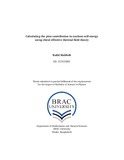Calculating the pion contribution to nucleon self-energy using chiral effective thermal field theory
Abstract
Effective field theories have proven to be efficient tools for studying physics at length scales longer than that which is typical. Chiral Perturbation Theory is one of these EFTs which physicists rely on heavily to study low energy QCD processes. The primary objective of this thesis is to calculate the nucleon self-energy which arises from the one-pion exchange. Chiral symmetries and spontaneous symmetry breaking schemes are discussed along with the emergence of pions as pseudo-Nambu-Goldstone bosons. Using the nonlinear σmodel, a chiral effective pion-nucleon Lagrangian is derived, which contains the necessary information to produce the nucleon self-energy diagram to the lowest order. In this work, the nucleon self-energy is evaluated using a somewhat simplistic numerical implementation and compared with the result from another source. It is seen that Σ(p) increases with momentum p, however, with large deviations from what should be expected due to the rudimentary computational methods used.

